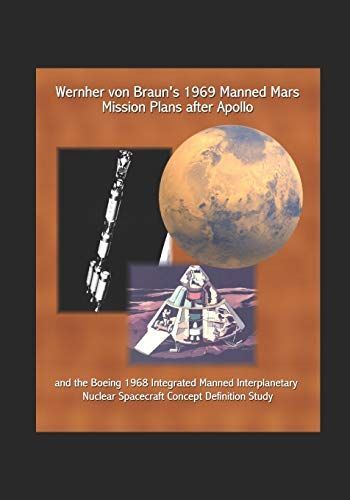
Wernher Von Braun's 1969 Manned Mars Mission Plans After Apollo and the Boeing 1968 Integrated Manned Interplanetary Nuclear Spacecraft Concept Definition Study
With the success of the Apollo 11 landing on the Moon, Wernher von Braun presented an ambitious plan for manned missions to Mars as soon as the 1980s to the Space Task Group for consideration by President Richard Nixon as the next step in America's space program. Nixon rejected the plan, and the goal of humans on Mars remains unfulfilled. Here are the technical details of his incredible nuclear rocket powered proposal, which was based on studies by Boeing in 1968. Contents: Boeing 1968 Study Volume 1 * Boeing 1968 Study Volume 2 * 1969 von Braun Manned Mars Mission Proposal * von Braun's Integrated Space Program, 1970-1990. In his presentation, von Braun wrote: With the recent accomplishment of the manned lunar landing, the next frontier is manned exploration of the planets. Perhaps the most significant scientific question is the possibility of extraterrestrial life in our solar system. Manned planetary flight provides the opportunity to resolve this universal question thus capturing international interest and cooperation. The information presented here describes a method of landing men on the planet Mars in 1982. The scientific goals of the mission are described and the key decision dates are identified. The 1981 manned Mars mission (1982 landing on Mars) is shown as an integral part of the total space program for the next two decades. The systems and experience resulting from the Apollo program and the missions proposed for the 1970's provide the technical and programmatic foundation for this undertaking. A 1982 manned Mars landing is a logical focus for the programs of the next decade. Although the undertaking of this mission will be a great national challenge, it represents no greater challenge than the commitment made in 1961 to land a man on the moon. Several different modes are possible for accomplishing Mars landing missions, each with its peculiar advantages and disadvantages. The typical Mars Landing Mission begins with the boost of the planetary vehicle elements into Earth orbit utilizing the Saturn V and Space Shuttle vehicles. Following assembly of the complete planetary vehicle in Earth orbit, the Earth departure phase of the mission is initiated. The Mars vehicle then begins a 270-day journey to Mars. This is by no means an idle phase of the mission. In addition to observations of Mars, many other experiments and measurements will be made on both the Earth-to-Mars and Mars-to-Earth legs of the trip that are of prime scientific importance. The spacecraft represents a manned laboratory in space, free of the disturbing influences of the Earth. The fact that there will be two observation points, Earth and the spacecraft, permits several possible experiments regarding the temporal and spatial features of the interplanetary environment. In addition, the spacecraft can be used to supplement and extend numerous observations conducted from Earth orbital space stations, particularly in the field of astronomy. It is possible, for example, that as yet unidentified comets might be observed for the first time.
Reviews
Patrick Anquetil @panquetil